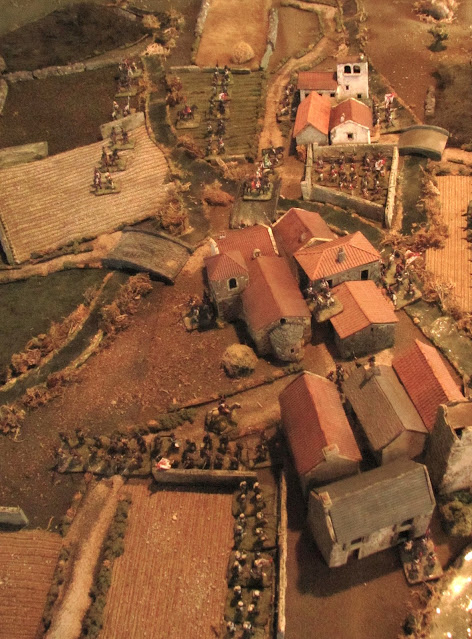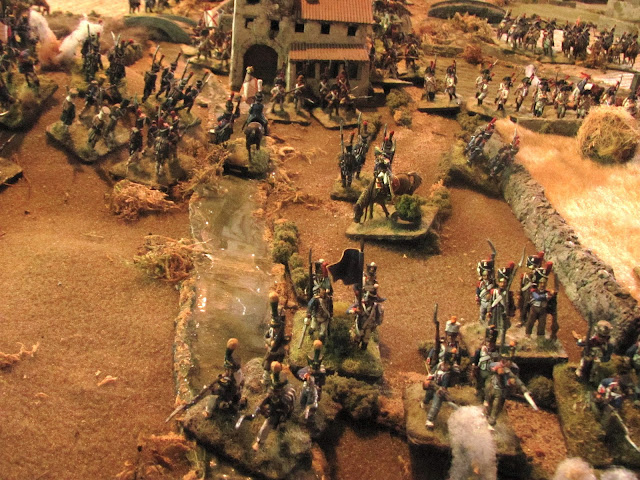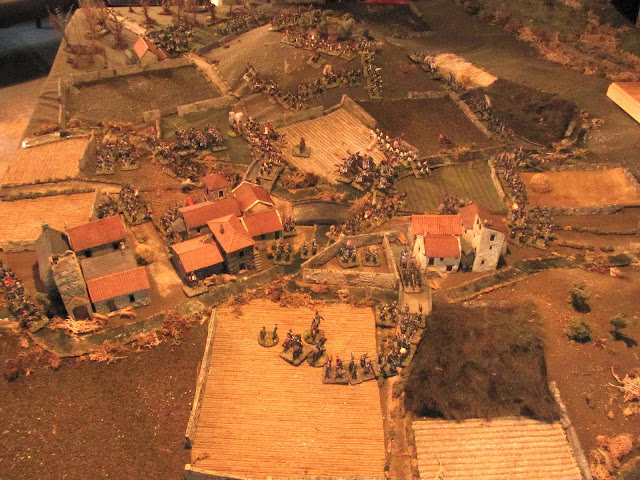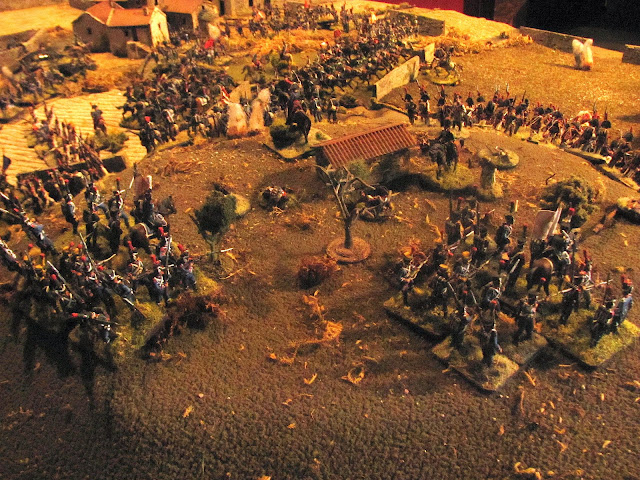We had a really interesting game last weekend, another Peninsular War scenario from the fertile brain of Brian North, based on the cat and mouse games Ballesteros played with the French behind enemy lines in Estremadura and Andalucia in the mid-war period.
From Brian’s introduction:
The battle is a minor occurrence during Soult’s invasion on Estremadura in January-March 1811, with the intention of taking Badajoz. Ballesteros commanded an Asturian division (an ‘expeditionary force’ – Asturias’ main contribution to date in the conflict) and after the 1809 Tamanes campaign, he operated from 1810-1812 behind enemy lines, harassing the French occupation of Estremadura and Andalucia and joining Beresford for the Battle of Albuera, while retreating to various mountain strongholds or the guns of Gibraltar when pressed too hard. By coincidence, while Soult was marching North, Ballesteros was marching South to the Niebla on a parallel road, only four miles away, which led to an initial indecisive clash with Gazan on 4th January at Calera de Léon. Rémond’s flying column had been shadowing Ballesteros, but, in order to ensure the safety of his slow moving siege train, Soult sent Gazan’s entire division after Ballesteros, who pulled back Southeast. Gazan, calling in Rémond, chased after him for three weeks. Having received some slight reinforcements, Ballesteros decided to give battle on 25th January, before leaving Spain, in a strong position at Villanueva de los Castillejos.
In this game the French are tasked with driving the Spanish out of the villages and to break them while taking as few casualties as possible while the Spanish aim is to hold up the French for as long as possible, inflict damage and then retreat off the board before game end in good order. The game was played on a 6’X8’ table using the Over the Hills ruleset and my own Spanish and French 1/72 figures. Alan took the Spanish while Brian and I ran the French, with Brian playing Pépin, and later, Rémond and my taking on Marasin’s brigade and Gazan’s command role.
The Battlefield
Ballesteros as played by Alan opts to not place the Spanish light infantry units forward, as they were historically, but rather build his defence around the twin villages of El Almendro (right) and Villanueva (left), separated by a large walled section in the middle. Forking streams, no great obstacle but full enough in January to make them difficult to negotiate, run around both sides of the villages.
In the foreground, where Gazan and Marasin’s brigade will enter, is rough ground, giving way to large fields lined with some broken walls. Bottom right is Pépin’s entry point, all high ground, and much of it impassable, where historically the Spanish light infantry fought a staged retreat as they fell back on the villages.
Behind the villages stands the large Cabeza del Pie de Castillo.
Spanish lines
Gastelu’s stronger brigade of four battalions garrison the two built up areas to the bottom that make up Villanueva, with Lena and Infiesto in reserve, while Morena’s brigade defends El Almendro (Pravia) and the walled area in the centre (2nd Barbastro). To the rear of the villages (top left) stand Alberquerque’s small brigade of Cazadores and guerrilla units.
Unknown to the French, a large contingent of Spanish cavalry, the Provisional Santiago line cavalry and Hussares de Castilla lie hidden behind the Cabeza de Pie de Castillo, in an ambush position.
Lena begins pushed out front guarding the first bridge where the road Marasin enters by exits the rough ground.
French advance
Marasin’s brigade, the 28th Legere and 100th Ligne with three battalions each, enter the field in columns of division and, viewing Lena at the bridge, promptly deploy into skirmish and open order to outflank the Spanish battalion. Lena in turn beats a hasty retreat back to Villanueva. Gazan dispatches Rémond’s mixed brigade made up of the 9th Dragoons and the1/16th Legere (not on the table - yet) to loop far around to the Spanish rear to cut off their retreat.
Spanish cavalry emerge from behind the Cabeza del Pie de Castillo
Ballesteros, seeing the French horse ride off, orders his own cavalry forward from their hidden position behind the Cabeza.
Lena withdraws through the villages to take up a new position on the Spanish left.
Pépin arrives on the Majadol Alto
Tasked by Gazan to clear the right flank of any Spanish before linking up north of El Almendro, Pépin marches through the high ground unobstructed.
Gazan shifts Marasin's attack to the south
Meanwhile, seeing the Spanish cavalry emerge north of the villages to block his way, Gazan shifts Marasin’s attack to the south, hoping to split the attention of the Spanish horse. Leaving the 2/28th Legere to ward off the enemy cavalry he sends out an ADC with new orders to Pépin to “Engage Spanish in and around El Almendro (as enemy cavalry allows); assault town if good opportunity presents itself.” As with all orders, these are open to interpretation…
Difficult going as Pépin slogs it through the high ground
Castropol garrisoning the southern part of Villanueva
The Spanish in the south of Villanueva look on nervously as the French and their artillery approach.
Marasin's shift to the south
Pépin descends towards El Almendro
Finally Pépin’s brigade begins to emerge from the high ground to discover the Spanish heavy cavalry to his front.
Ballesteros repositions his lines
However, before Pépin can decide how to deploy in the face of the Spanish horse, Ballesteros pulls his heavy cavalry out of the line to protect against any French incursion around the Spanish right (centre). At the same time the Hussares (bottom right) move forward to support Morena’s troops in and around El Almendro while his Cazadores (bottom left), brought forward, are sent back to the rear to join the guerrillas in forming a reserve on the Cabeza.
Pépin forms up to attack El Almendro
With the enemy cavalry on the move Pépin makes good use of the breathing space to debouch from the hills and form up for a concerted attack on El Almendro. Here his light infantry engage Pavia with skirmish fire while the two battalions of the 103rd form columns of division in preparation to attack.
Pépin's 103rd Ligne assault Pravia in El Almendro
The 2nd and 3rd battalions charge in…
And are beaten back!
Pravia puts up a stiff defence, routing the 3/103 and driving back the 2/103 through its supports.
Marasin also moves into position on the south flank
Meanwhile Marasin has begun to engage Castropol at the south end of Villanueva with skirmish fire while he maneuvers his 4 pdr. guns into canister range, in order to soften up the defence.
Marasin successfully seizes southern Villanueva
The tactic works as Castropol, battered by small arms fire and canister are swiftly ousted at bayonet point by the 2/100th Ligne.
Provincial Leon counterattack...
Before the 2/100th can get firmly ensconced in the village, the Spanish Provincial Leon, in reserve to the west of the village, counterattack (left) - but unsuccessfully. They, too, are beaten back and join Castropol in routing towards the rear.
Overview
In this overview on the far left, Leon and Castropol rout from the south end of Villanueva while the French take the first of the three village sectors. To the right of this 2/28th Legere engage in a firefight with 2nd Barbastro (in the walled area) while Pépin is repelled from the precincts of El Almendro (right).
Behind the towns the two Spanish cavalry units, Santiago on the left and the Hussares on the right, keep the French from making any incursions around the Spanish flanks.
Lena breaks the 3/21 Legere in their attack
Trying a different tack, Pépin charges Lena who are in line behind a wall west of El Almendro. Lena delivers a blistering first volley and then throws back and breaks the French attackers in close combat.
Spanish begin to withdraw
At this point, with the southern half of Villanueva lost and Marasin repositioning his artillery and battalions to attack the northern sector of Villanueva, Ballesteros decides it is time to withdraw. He orders a retreat in stages to the Cabeza where Alberquerque’s guerrillas and cazadores form a reserve.
In this picture, while the French cavalry cover the retreat, Cangas de Tieno moves out of the northern half of Villanueva (centre left)and marches over the bridge to the rear while Pravia abandons El Almendro to the French.
Unfortunately, at this crucial juncture Ballesteros, riding into El Almendro to try to rally the besieged Pravia, takes a musket ball and is laid low. His second command takes over but without the strict discipline of their charismatic leader the Spanish withdrawal begins to unravel at the exact moment when it is needed the most!
Gazan orders the French to pursue
Gazan orders his brigadiers to maintain contact and pursue, but the presence of 2nd Barbastro in the walled area holds up Masarin from moving through the centre.
Pépin presses forward, occupies El Almendro
But Pépin's advance is still held up by the Spanish Hussares and Lena, who withdraw slowly and in an orderly fashion, protecting the Spanish left.
Rémond arrives behind the Spanish lines
The Spanish problems are compounded by the sudden arrival of Rémond’s dragoons and light infantry to their rear. Their small reserve on the Cabeza, only the guerrillas and the now rallied but still-recovering Castropol, although safe from cavalry attacks is forced to defend from a possible attack by the 16th Legere as well.
16th Legere form line on the west side of the Cabeza while the 9th Dragons threaten along the road south of the hill.
2nd Barbastro last unit to evacuate the villages
With the French now occupying both villages 2nd Barbastro exits the walled area and begins to fall back.
Overview
In this overview, left to right, Masarin begins to cautiously edge around the south end of Villanueva but the presence of the Spanish Santiago still keep him pinned. In the centre Masarin’s guns wind their way though the villages while Pépin advances in the face of the Spanish rearguard. Far upper right, crucially, you can see the 1st and 2nd 21st Legere making their way to the north flank of the Cabeza.
Four Spanish units, mostly badly battered, have made it to the Cabeza (top centre) where their commanders attempt to form them into some sort of defensive line, really a square as they are now threatened from all sides.
The Spanish retreat, although still relatively orderly is hindered by the stream that lies to their backs and, even more so, with Ballesteros (and his 4/+2 command rating) gone it is almost impossible for the Spanish to rally off any fatigue hits, making them very brittle.
1st and 2nd Battalions, 21st Legere storm the Cabeza
With the sun low on the horizon and the Spanish threatening to slip away, Pépin throws his two remaining light infantry battalions into the attack, who, seeing the same Spanish troops who had held them at bay in El Almendro, charge with a vengeance. Pravia takes it head on and, after delivering a ragged volley, is soundly thrashed.
And carry the summit...
The Legere’s momentum carries them over the summit, crashing into two more Spanish battalions, hitting their flanks, annihilating one and routing the second which in turn, passing through the ranks of the fourth causes it to rout as well. The Cabeza is swept clean.
The remaining defenders on the Cabeza are swept into the arms of Rémond’s cannon and light infantry
Marasin and dragoons go into the attack west of Villanueva
At the same moment, Marasin and Rémond’s dragoons attack. The dragoons, suddenly emerging on Santiago’s flank, manage to form up as the Spanish horse reorient their line and charge. Seeing this Marasin’s 3/28 Legere sally out of Villanueva to attack the retreating Spanish infantry.
Cavalry charge
The two heavy cavalry units clash, and in a bloody mélee the French get the better of their opponents, who rout and then break on passing through their own troops to the rear.
3/28th Legere sallies out of Villanueva
2nd Barbastro meets the French charge at the bridge. The French break this battalion and then hit Infiesto, who also break.
Game end
With these crippling losses the Spanish, after a strong defence of the villages, are well and truly broken and stream back towards the Portuguese frontier, leaving many dead and captured.
The French having lost a battalion earlier, can only claim a minor victory against their opponents. The game, 16 turns in length, went 14 turns without the Spanish losing a single unit. If they were allowed to remain in the villages they may well have survived to game end, but the victory conditions required them to stage a retreat by game’s end.
But on the 14th round the accumulated fatigue hits that the Spanish were unable to shed led them to be very brittle, as seen when the French finally had the opportunity to put in a concerted attack, unhindered by the enemy cavalry.




































A fantastic game with your usual high standard of set up/terrain. I really enjoyed reading the report and look forward to trying out the scenario. Looks like it was all to play for right up to the last few turns.
ReplyDeleteThanks, Andrew. I actually want to play this one out a second time - it was an interesting challenge for both sides.
Delete